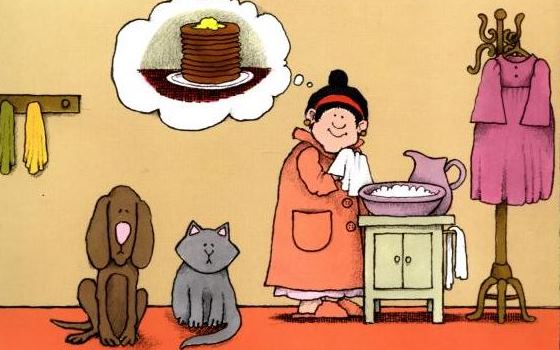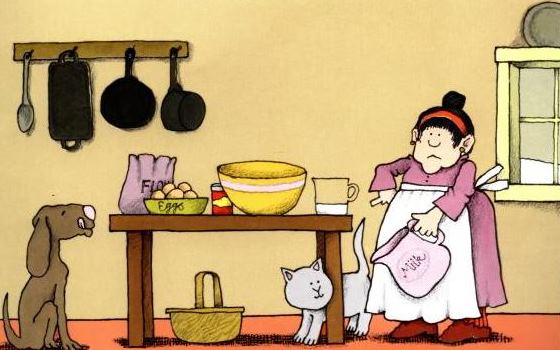"Wordless books". When I first heard the term I couldn't help but think it was contradictory; like an oxymoron (jumbo shrimp, pretty ugly, working vacation...).
Wordless books contain no words or very few words and tell a story through pictures.
These books are wonderful resources for work on language skills and for social skills training. Here are some general ideas.
For speech or language impaired children, oftentimes they only need help with expressing ideas. If they already know how to "read" scenes and interpret them, then we can focus on the expression of those ideas:
- Verbal expression: Have the child look at the pictures and tell the story in his own words.
- Written expression: The child writes sentences to match the page. Or, older children can write an entire story to go with the pictures.
- Answer questions about the scenes.
- Ask questions about the scenes.
- Inference: What can we infer based on the pictures?
For children with social pragmatic disorders, we need to help them learn to "read" the scenes. We can do this by asking specific questions while pointing out things that lead to correct answers. The skills areas often weak with these children include the following:
- Gestalt processing: Figure out what is going on by observing the whole picture.
- Coherence: Link the interpretation of each page in relation to what was happening on the previous page (rather than interpreting each page at face value/as a new thought).
- Emotional understanding: Observe the facial expressions to help interpret or to assign emotional states to characters (thus making more accurate interpretations).
- Prior knowledge: try to recall personal experiences with the scenes/situations/feelings
- Inference based on our prior experiences/knowledge.
Pancakes for Breakfast
This is a great book for language skills since it provides a sequence of events that can be used to tell a story from beginning to end. It is also excellent for social pragmatic language due to its use of thought bubbles to show what the character's intentions are; although many things go wrong in her plans. It is better to "guide" a child into making his own correct discoveries rather than "telling" him what is going on. By guiding him with questions and pointing out things he may have missed, we teach him to sharpen his own observation skills and thinking processes. Plus we all learn by doing so much more efficiently than we learn by being told.
- What time of day? The woman has on a robe and is washing her face so it is either morning or night just before going to bed. (Interpretation/gestalt processing)
- What is she thinking about? Pancakes. Why?
- When do we usually have pancakes? Breakfast. (prior knowledge)
- If she is thinking about eating breakfast, then what time of day is it? Morning.
- What will she do next: cook pancakes or get dressed? (Sequential processing/personal knowledge)
- What do you do first in the morning?
- Do you think she likes animals? She has a cat and dog so she probably does.(Inference)
- How does she feel right now? Happy. How do we know this? She is smiling. (Reading emotions)
- How does she feel here? Sad. (Emotional understanding).
- What are other emotions she might be feeling? Disappointed
- What is wrong? Based on the previous pages: she has run out of something. (Identifying a problem)
- What does she need now? Milk.
- Why do you think this? She is holding the pitcher in her hand and the cup only has a little milk. (Problem Solving)
- How do you think she will get more? go to the store.
- She lives on a farm. What is another way she can get milk? Milk the cow. (Alternate Solutions - Flexible thinking)
a boy, a dog, and a frog
This book shows the story of a boy who goes to the pond with his dog one day. They get try to catch a frog who outsmarts them. However, when they go home wet and disappointed, the frog is lonely and decides to follow them home. This book is great for retelling for language skills due to a sequential storyline. It is also great for social pragmatics. Some to the social areas that can be drawn out it include:
- Emotion Reading: Facial expressions on boy, dog, and frog
- Eye gaze: what is the boy looking at? What is he thinking/planning?
- Prediction: What will happen next?
- Inference: Why does he feel this way? How did the frog feel about the boy trying to catch him? Afraid, mad, happy. Since he followed him home, he must have liked the boy.
The Snowman
This is the story of a boy who builds a snowman that comes alive at night and becomes his friend. The boy shares his home with the Snowman who then reciprocates and shows the boy his world. It is great for the following skills:
- Reading scenes and making correct interpretations.
- Use of Eyes: What's the boy looking at? What's he thinking about? Social Thinking (R) Concept of what we look at is generally what we are thinking about.
- Inference: The snowman is afraid of the stove. Why?
- Reading emotional states.
- Friendship




